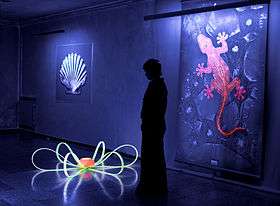Day-Glo Color Corp.
The Day-Glo Color Corp. (DayGlo) is an American, privately held[2] paint and pigments manufacturer based in Cleveland, Ohio. It was founded in 1946 by brothers Joseph and Robert Switzer and is currently owned by RPM International. DayGlo specializes in producing fluorescent paint and pigments, such as those used in safety applications, artwork and signage. The company invented both black-light fluorescent and daylight fluorescent paints and nondestructive testing methods that use fluorescent dyes.
 Black light fluorescent paints were first developed by DayGlo Color Corp. in the 1930s. | |
| Private | |
| Industry | Paint and pigments production |
| Predecessor | Switzer Brothers, Inc. |
| Founded | 1946 in Berkeley, California, United States |
| Founders | Robert and Joseph Switzer |
| Headquarters | Cleveland , Ohio, USA |
Area served | Worldwide |
Key people | Steve Jackson, President[1] |
| Products | Fluorescent paints |
History
Brothers Robert and Joseph Switzer of Berkeley, California, began investigating fluorescence in the 1930s using a black light to identify naturally occurring fluorescent compounds, hitting first upon Murine eye wash.[3] By mixing these compounds with shellac, they invented the first black light fluorescent paints.[4] Joseph used these paints in his amateur magic show and sold magic kits based on the black light fluorescent costumes they created.[4]
The brothers established the Fluor-S-Art Co. in 1934 to develop and sell black light paints for advertising purposes.[4][5] The company later partnered with Continental Lithograph (a subsidiary of Warner Brothers Pictures) of Cleveland, Ohio, to develop fluorescent paints for use in movie posters and advertising displays.[6] In 1936, the brothers moved their company to Cleveland, which was a center of the paint manufacturing industry.[7]
In 1938, the brothers invented Zyglo and Magnaglo, two flaw-detection processes that used fluorescent dyes. The dyes penetrate defects in machined parts, allowing the defects to be detected by inspecting the parts under black light.[6] (Magnaglo was based on a preceding process of magnetic particle inspection that detects flaws in ferromagnetic materials. Because Magnaglo uses fluorescence instead of magnetism, the process can be used on non-ferromagnetic materials.) After a dispute with Continental Lithograph over the rights to Zyglo and Magnaglo, the brothers established the independent Switzer Brothers, Inc., in 1946 to continue developing and marketing new uses for fluorescent materials.[6] The company changed its name to Day-Glo Color Corp. in 1969.[7]
In the 1940s, the company began developing a new class of pigments called daylight fluorescent pigments that fluoresce in daylight. These pigments convert ultraviolet light to visible light, resulting in color that is comparatively brighter than other types of pigments. This class of pigments is also known as DayGlo.[4]
During World War II, DayGlo products were extensively used by the U.S. military in applications where visibility was required. U.S. ground troops in North Africa identified themselves using daylight fluorescent fabric panels to prevent friendly fire bombings by pilots, and DayGlo paints were used on aircraft to prevent mid-air collisions. Navy air carriers used DayGlo's black light fluorescent paints to allow planes to land at night, an advantage that enemy pilots did not have.[5] Military equipment manufacturers, particularly those of aircraft parts, employed DayGlo's Zyglo and Magnaglo processes to identify defects in metal fabricated parts.[6]
.jpg)
After the war, daylight fluorescent paints were used by advertisers to make their products more visible to consumers. Tide detergent became known for its fluorescent packaging beginning in 1959, but other products such as clothing, posters and hula hoops also used daylight fluorescent colors.[5][6] Daylight fluorescent pigments were also used across safety applications such as construction cones, street signs and safety vests, due to their high visibility.[4]
DayGlo pigments were popularized in the 1960s by their extensive use in psychedelic art, such as the album artwork for Cream's 1967 album, Disraeli Gears.[8][9][10] In February, 1969 the company changed its name to DayGlo Color Corp. from Switzer Brothers, Inc.[2]
In September, 1985 Nalco Chemical Company of Oak Brook purchased Day-Glo Color for approximately $40 million in cash.[11]
In 2012, Day-Glo Color Corp. was recognized as a National Historic Chemical Landmark for its development of daylight fluorescent pigments.[12]
The company has manufacturing plants in Twinsburg, Ohio; Cudahy, California;[13] and Houthalen, Belgium.[14][15]
Community involvement
The company sponsors an annual DayGlo Show. Day-Glo donates gallons of its paint to artists in Northeast Ohio. The artists use the paint to create original two- and three dimensional artwork. The pieces are then displayed in a gallery lit with UV light, (black light).[15]
References
- "Day-Glo Color Corp". Manta.com. Retrieved 8 May 2017.
- "Company Overview of DayGlo Color Corp". Bloomberg. 8 May 2017. Retrieved 8 May 2017.
- Ensminger, David. "Black Light Panthers: The Politics of Fluorescence," Art in Print Vol. 5 No. 2 (July–August 2015).
- "DayGlo Fluorescent Pigments National Historic Chemical Landmark". American Chemical Society. Retrieved 2016-03-20.
- Johnston, David Cay (August 29, 1997). "Robert Switzer, Co-Inventor Of Day-Glo Paint, Dies at 83". The New York Times. ISSN 0362-4331. Retrieved 2016-03-20.
- Bing, Liesa (1991). The Story of Day-Glo.
- "Encyclopedia of Cleveland History: SWITZER, ROBERT C." ech.case.edu. Retrieved 2016-03-23.
- "Martin Sharp – obituary". The Telegraph. December 2, 2013. Retrieved March 29, 2016.
- Rielly, Edward J. (January 1, 2003). The 1960s. Greenwood Publishing Group. ISBN 9780313312618.
- "Cream Disraeli Gears Album Review". Rolling Stone. Retrieved 2016-03-29.
- "Nalco Now Owns Day-glo". Chicago Tribune. 27 September 1985. Retrieved 8 May 2017.
- Wang, Linda. "Landmark Achievement For Day-Glo Color | Chemical & Engineering News". cen.acs.org. Retrieved 2016-03-20.
- "Day-Glo". Manta.com. Retrieved 8 May 2017.
- "Day-glo Buys Belgian Firm". Chicago Tribune. 12 August 1987. Retrieved 8 May 2017.
- Usmani, Josh (3 January 2017). "Fifth Annual DayGlo Show Will Color Walk All Over Waterloo". Clevescene. Scene. Retrieved 8 May 2017.